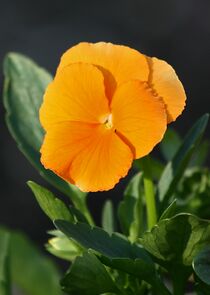زريعة

A cultivar selected for its intriguing and colourful flowers
الزُرَيْعة cultivar هي نوع من النبات that people have bred for desired traits, which are reproduced in each new generation by a method such as grafting, tissue culture or carefully controlled seed production. Most cultivars arise from purposeful human manipulation, but some originate from wild plants that have distinctive characteristics. Cultivar names are chosen according to rules of the International Code of Nomenclature for Cultivated Plants (ICNCP), and not all cultivated plants qualify as cultivars. Horticulturists generally believe the word cultivar[nb 1] was coined as a term which means "cultivated variety".
Popular ornamental garden plants like roses, camellias, daffodils, rhododendrons, and azaleas are commonly cultivars produced by breeding and selection or as sports, for floral colour or size, plant form, or other desirable characteristics.[1] Similarly, the world's agricultural food crops are almost exclusively cultivars that have been selected for characters such as improved yield, flavour, and resistance to disease, and very few wild plants are now used as food sources. Trees used in forestry are also special selections grown for their enhanced quality and yield of timber.
Cultivars form a major part of Liberty Hyde Bailey's broader group, the cultigen,[2] which is defined as a plant whose origin or selection is primarily due to intentional human activity.[3] A cultivar is not the same as a botanical variety,[4] which is a taxonomic rank below subspecies, and there are differences in the rules for creating and using the names of botanical varieties and cultivars. In recent times, the naming of cultivars has been complicated by the use of statutory patents for plants and recognition of plant breeders' rights.[5]
The International Union for the Protection of New Varieties of Plants (UPOV – فرنسية: Union internationale pour la protection des obtentions végétales) offers legal protection of plant cultivars to persons or organisations that introduce new cultivars to commerce. UPOV requires that a cultivar be "distinct, uniform", and "stable". To be "distinct", it must have characters that easily distinguish it from any other known cultivar. To be "uniform" and "stable", the cultivar must retain these characters in repeated propagation.
The naming of cultivars is an important aspect of cultivated plant taxonomy, and the correct naming of a cultivar is prescribed by the Rules and Recommendations of the International Code of Nomenclature for Cultivated Plants (ICNCP, commonly denominated the Cultivated Plant Code). A cultivar is given a cultivar name, which consists of the scientific Latin botanical name followed by a cultivar epithet. The cultivar epithet is usually in a vernacular language. For example, the full cultivar name of the King Edward potato is Solanum tuberosum 'King Edward'. 'King Edward' is the cultivar epithet, which, according to the Rules of the Cultivated Plant Code, is bounded by single quotation marks.[6]
أصل الاسم
Cultigens
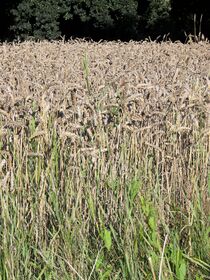
Formal definition
The Cultivated Plant Code notes that the word cultivar is used in two different senses: first, as a "classification category" the cultivar is defined in Article 2 of the International Code of Nomenclature for Cultivated Plants (2009, 8th edition) as follows: The basic category of cultivated plants whose nomenclature is governed by this Code is the cultivar.[7] There are two other classification categories for cultigens, the grex[8] and the group.[9] The Code then defines a cultivar as a "taxonomic unit within the classification category of cultivar". This is the sense of cultivar that is most generally understood and which is used as a general definition.
A cultivar is an assemblage of plants that (a) has been selected for a particular character or combination of characters, (b) is distinct, uniform and stable in those characters, and (c) when propagated by appropriate means, retains those characters.[10]
Different kinds
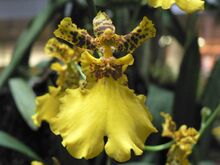
Which plants are chosen to be named as cultivars is simply a matter of convenience as the category was created to serve the practical needs of horticulture, agriculture, and forestry.[11]
Clones
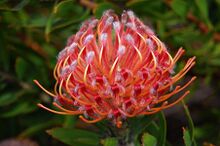
A cross performed in Tasmania between L. glabrum and L. tottum
Genetically modified
Genetically modified plants with characteristics resulting from the deliberate implantation of genetic material from a different germplasm may form a cultivar. However, the International Code of Nomenclature for Cultivated Plants notes, "In practice such an assemblage is often marketed from one or more lines or multilines that have been genetically modified. These lines or multilines often remain in a constant state of development which makes the naming of such an assemblage as a cultivar a futile exercise."[12] However, retired transgenic varieties such as the fish tomato, which are no longer being developed, do not run into this obstacle and can be given a cultivar name.
Cultivars may be selected because of a change in the ploidy level of a plant which may produce more desirable characteristics.
Cultivar names
Every unique cultivar has a unique name within its denomination class (which is almost always the genus). Names of cultivars are regulated by the International Code of Nomenclature for Cultivated Plants, and may be registered with an International Cultivar Registration Authority (ICRA). There are sometimes separate registration authorities for different plant types such as roses and camellias. In addition, cultivars may be associated with commercial marketing names referred to in the Cultivated Plant Code as "trade designations" (see below).
International Cultivar Registration Authorities
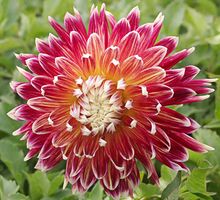
A cultivar selected for flower form and colour
An International Cultivar Registration Authority (ICRA) is a voluntary, non-statutory organization appointed by the Commission for Nomenclature and Cultivar Registration of the International Society of Horticultural Science. ICRAs are generally formed by societies and institutions specializing in particular plant genera such as Dahlia or Rhododendron and are currently located in Europe, North America, China, India, Singapore, Australia, New Zealand, South Africa and Puerto Rico.[13]
انظر أيضاً
ملاحظات
- ^ Cultivar (English: /ˈkʌltɪˌvɑːr, -ˌvɛər/) has two meanings, as explained in Formal definition: it is a classification category and a taxonomic unit within the category. When referring to a taxon, the word does not apply to an individual plant but to all plants that share the unique characteristics that define the cultivar.
المراجع
- ^ Stanley J. Kays (3 October 2011). Cultivated vegetables of the world: a multilingual onomasticon. Springer. pp. 15–. ISBN 978-90-8686-720-2.
- ^ Bailey 1923, p. 113
- ^ Spencer & Cross 2007, p. 938
- ^ Lawrence 1953, pp. 19–20
- ^ See
- ^ Cultivated Plant Code Article 14.1 Brickell 2009, p. 19
- ^ Cultivated Plant Code. Art. 2.1 Brickell 2009, p. 6
- ^ Cultivated Plant Code. Art. 4 Brickell 2009, p. 12
- ^ Cultivated Plant Code. Art. 3 Brickell 2009, pp. 10–12
- ^ Cultivated Plant Code. Art. 2.2 Brickell 2009, p. 6
- ^ Cultivated Plant Code. Preamble & Principles Brickell 2009, p. 19
- ^ Cultivated Plant Code, Articles 2.19 Brickell 2009, pp. 8–9
- ^ Cultivated Plant Code Brickell 2009, pp. 62, 67–83
خطأ استشهاد: الوسم <ref> ذو الاسم "AusNatBotGard-names-1995" المُعرّف في <references> غير مستخدم في النص السابق.
خطأ استشهاد: الوسم <ref> ذو الاسم "FAO-names" المُعرّف في <references> غير مستخدم في النص السابق.
خطأ استشهاد: الوسم <ref> ذو الاسم "TAMU-names" المُعرّف في <references> غير مستخدم في النص السابق.
خطأ استشهاد: الوسم <ref> ذو الاسم "NYBG-names" المُعرّف في <references> غير مستخدم في النص السابق.
<ref> ذو الاسم "Chen-et-al-2018" المُعرّف في <references> غير مستخدم في النص السابق.ببليوگرافيا
- Bailey, Liberty Hyde (1923). "Various cultigens, and transfers in nomenclature". Gentes Herbarum. 1 (Part 3): 113–136.
- Brickell, Chris D. et al. (eds) (2009). "International Code of Nomenclature for Cultivated Plants (ICNCP or Cultivated Plant Code) incorporating the Rules and Recommendations for naming plants in cultivation. 8th ed., adopted by the International Union of Biological Sciences International Commission for the Nomenclature of Cultivated Plants" (PDF). Scripta Horticulturae. International Society of Horticultural Science. 10: 1–184. ISBN 978-90-6605-662-6.
{{cite journal}}:|first=has generic name (help) - Lawrence, George H.M. (1953). "Cultivar, Distinguished from Variety". Baileya. 1: 19–20.
- Lawrence, George H.M. (1955). "The Term and Category of Cultivar". Baileya. 3: 177–181.
- Lawrence, George H.M. (1957). "The Designation of Cultivar-names". Baileya. 5: 162–165.
- Lawrence, George H.M. (1960). "Notes on Cultivar Names". Baileya. 8: 1–4.
- Morton, Alan G. (1981). History of Botanical Science: An Account of the Development of Botany from Ancient Times to the Present Day. London: Academic Press. ISBN 0-12-508382-3.
- Spencer, Roger; Cross, Robert; Lumley, Peter (2007). Plant names: a guide to botanical nomenclature. (3rd ed.). Collingwood, Australia: CSIRO Publishing (also Earthscan, UK.). ISBN 978-0-643-09440-6.
- Spencer, Roger D.; Cross, Robert G. (2007). "The International Code of Botanical Nomenclature (ICBN), the International Code of Nomenclature for Cultivated Plants (ICNCP), and the cultigen". Taxon. 56 (3): 938–940. doi:10.2307/25065875. JSTOR 25065875.
- Trehane, Piers (2004). "50 years of the International Code of Nomenclature for Cultivated Plants". Acta Horticulturae. 634: 17–27. doi:10.17660/ActaHortic.2004.634.1.
وصلات خارجية
- Sale point of the Latest Edition (October 2009) of The International Code of Nomenclature for Cultivated Plants
- International Cultivar Registration Authorities
- The Language of Horticulture
- Opinion piece by Tony Lord (from The Plantsman magazine)
- Hortivar – The Food and Agriculture Organization of the United Nations Horticulture Cultivars Performance Database
